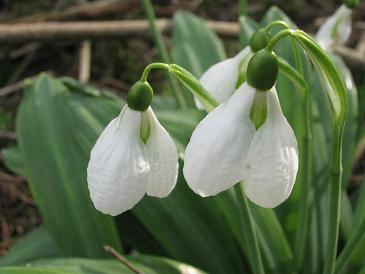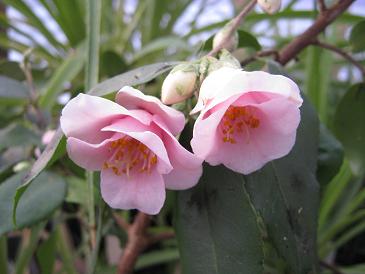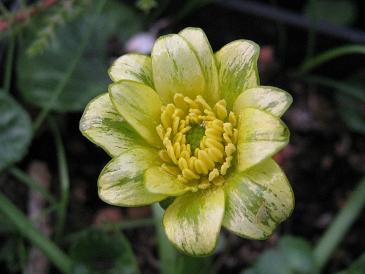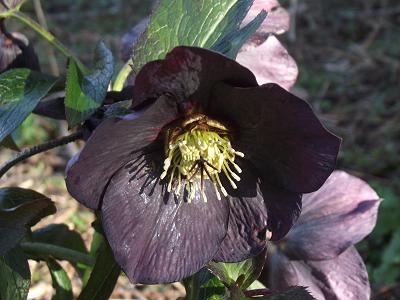JEARRARD'S HERBAL
Thats enough introduction - on with the plants!
To navigate this site, use the links above, or the detailed links at the bottom of this page.
... out in the garden.
6th March 2011

Galanthus 'Augustus' .
The last couple of weeks have spent on tenterhooks, wondering if we have seen the last of the cold weather. This week the answer has become clear - not quite!
The last few days of the week have been bathed in a chilly east wind , and the (beautiful) clear days have been followed by (I don't care I sleep through them)
cold nights. Local gardeners have reported frosts, but I haven't been out of bed fast enough to see them, and there hasn't been any damage on the flowers that are open
so it hasn't really mattered. The coming week promises a return to dull and mild, so with luck that is the last of it.
This snowdrop is one of my favourites, despite the fact that it has a problem with virus infection. It was named after E.A.Bowles (one of my horticultural heroes -
solitary, grumpy, idiosyncratic, oh, and talented) by Amy Doncaster, though it originated with Lewis Palmer. It probably never grew in Bowles garden at Myddleton House.
Certainly it wasn't there when I first got to know the garden in the early 80's. Since then the garden has been reinvigorated (I daren't say 're-discovered',
it was never really lost, just underfunded and I'm sure that remains true) and I expect this snowdrop occupies a prized place. It's a good thing.
6th March 2011
 Camellia rosiflora 'Cascade' .
Camellia rosiflora 'Cascade' .
Camellia is a genus that attracts my attention for all the wrong reasons. At the start of the year when the fragile beauties of spring are just
daring to show their heads there is suddenly a burst of bilious pinkness, the chromatic equivalent of a fart in a string quartet. Fortunately,
there are a few that are a little more subtle in the spring sunshine.
I bought this last year and it has spent the winter under the bench in the greenhouse, but it hasn't been damaged so I think it will survive
outside. It is reputed to be rather slow growing, but I expect I can find a suitable corner. There has been some uncertainty about the name. It was initially though
to be a cultivated hybrid of C.sinensis (tea) but it is now reported to occur naturally in Jiangsu, Hubei, Zhejiang and Sichuan provinces
of China. This selection is rather frail and weeping but it demonstrates that there are some really lovely species for the garden
that are well worth seeking out.
6th March 2011

Ranunculus ficaria 'Limelight'
The Lesser Celandines have been in flower for a couple of weeks now. They are all still in pots in the greenhouse in order to keep the different cultivars
distinct, but I think they will all have to go out this year. The plants outside are all growing much more strongly, though they are occasionally
grazed to the base by rabbits. I will have to put up some little fences to protect them, but on balance I think they are better off outside.
'Limelight' is a large flowered cultivar with a cool greenish tinge to the flowers. Some years and some locations show its distinctness better than others,
and this is the most interesting flower I think I have ever seen. The pigment in Celandine tepals is found only in the surface layer of cells and as the
flowers age these peel off and degrade easily. If you look at a clump of plants, the old flowers are usually pale yellow with a darker eye as a consequence
of this beakdown. The same effect is causing the streaking seen in this flower.
Originally discovered in Devon by R.Hoskins in 1991, it produces plenty of seedlings. I have yet to see one that can match it for greenness
but I am sure there is potential for something even more wonderful.
6th March 2011

Helleborus x hybridus Black .
The Hellebores have been filling me with joy since the first of them flowered prematurely last autumn. I had been thinning some trees that shade the
Hellebore beds and decided that I needed to cut all the old foliage to the ground and in the process remove some of the competing vegetation.
I was quite worried about it as I rode back and forward on the mower but I think it was a good thing, though I don't think I will be doing it
every year. Certainly the beds are looking better than they ever have before, but it is still a young (ish) planting, so it might just be that
it is a year more mature.
I have spent years trying to get good pictures of the black and blue forms. I think they are best with the sun shining on them strongly
and pictured against a dark background. This is certainly closer to the way the plant looks in life. Hellebores naturally hang their heads
so that you have to bend and turn them up to appreciate the full beauty. In recent years breeders have introduced forms that look upward naturally.
There has been a certain amount of wibbling gibberish from the traditionalists but those of us with uncertain backs will look you in the eye
and salute you!
I spent a lot of time, energy (and unfortunately money) obtaining some really good blue forms, but as they establish in the garden many of my best blacks have
developed a greyish hue and I only have a few that are a good reliable anthracite black. Too late to do anything about it this year, but I may
have to spend some time next winter visiting the larger breeders.
To find particular groups of plants I grow, click on the genus name in the table above. Click on the "Index" box at the top of the page for the full list.
I have a lot of good intentions when it comes to updating this site, and I try to keep a note
about what is going on, if you are interested.
If you want to contact me, the address is infoMONKEYjohnjearrard.co.uk
When typing the address in, please replace MONKEY with the more traditional @ symbol! I apologise for the tiresome performance involved, but I am getting too much
spam from automated systems as a result of having an address on the front page.

 Camellia rosiflora 'Cascade' .
Camellia rosiflora 'Cascade' . 
